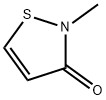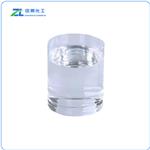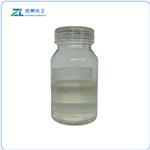Description
Methylisothiazolinone (also called 2-methyl-4-isothiazolin-3-one), is a powerful synthetic biocide and preservative within the group of isothiazolinones.
Methylisothiazolinone is used to control slime-forming bacteria, fungi, and algae in pulp/paper mills, cooling water systems, oil field operations, industrial process waters, and air washer systems. And it is incorporated into adhesives, coatings, fuels, metal working fluids, resin emulsions, paints, and various other specialty industrial products as a preservative. It is also used to control the growth of mold, mildew, and sapstain on wood products. It is generally recommended for use only in rinse-off and leave-on cosmetic products (maximum concentration of 100 ppm) as preservative such as shampoo, conditioner, hair color, body wash, lotion, sunscreen, mascara, shaving cream, baby lotion, baby shampoo, hairspray, makeup remover, liquid soaps, and detergents. Nevertheless, methylisothiazolinone is allergenic. It is reported that methylisothiazolinone in rinse-off products causes allergic contact dermatitis.
Uses
2-Methyl-4-isothiazolin-3-one, or MIT as it is sometimes known, is a preservative used in cosmetics and beauty products. It is a powerful biocide, or “chemical substance capable of killing living organisms, usually in a selective way.”Biocides are a general term that includes antimicrobial, germicide, antibiotic, and antifungal. Ultimately, Methylisothiazolinone is used to prevent a wide variety of bacteria and fungi from growing in cosmetics and beauty products, most often in shampoo. It is only approved for use in rinse-off formulas and at low concentrations.
Safety
Methylisothiazolinone (MIT) is a heterocyclic organic compound used as a preservative in cosmetics and personal care products in concentrations up to 0.01%. MIT is a colorless, clear liquid with a mild odor that is completely soluble in water; mostly soluble in acetonitrile, methanol, and hexane; and slightly soluble in xylene. Consistent with its solubility, dermal penetration is low. The Cosmetic Ingredient Review Expert Panel noted the in vitro evidence of neurotoxicity but concluded that the absence of any neurotoxicity findings in the many in vivo studies, including subchronic, chronic, and reproductive and developmental animal studies, suggests that MIT would not be neurotoxic as used in cosmetics. Although recognizing that MIT was a sensitizer in both animal and human studies, the panel concluded that there is a threshold dose response and that cosmetic products formulated to contain concentrations of MIT at 100 ppm (0.0 1%) or less would not be expected to pose a sensitization risk. Accordingly, MIT may be safely used as a preservative in cosmetics up to that concentration.
References
[1] http://www.safecosmetics.org/get-the-facts/chemicals-of-concern/methylisothiazolinone/
[2] K. Yazar, M. D. Lundov, A. Faurschou, M. Matura, A. Boman, J. D. Johansen, C. Lidén (2015) Methylisothiazolinone in rinse-off products causes allergic contact dermatitis: a repeated open-application study, 173, 115-122
[3] https://www3.epa.gov/pesticides/chem_search/reg_actions/reregistration/fs_G-58_1-Oct-98.pdf
Description
2-Methyl-4-isothiazolin-3-one (MI) is an isothiazolinone-derived biocide used for controlling microbial growth in industrial and household products, often in a mixture with 5-chloro-2-methyl-3-isothiazolone (MCI). MI is active against Gram-positive and Gram-negative bacteria, fungi, and yeast with MIC values of 0.0045, 0.0015, >0.01, and 0.0065% (w/w) for
S. aureus, P. aeruginosa, A. niger, and
C. albicans, respectively, when used alone. MIC values are 7 to 200-fold lower when MI is used in combination with MCI. MI decreases neurite outgrowth of rat cortical neurons when used at concentrations of 0.1-3 μM and inhibits Src family kinases in cell-free assays. MI, alone and as a mixture with MCI, can elicit contact sensitization.
Chemical Properties
2-Methyl-4-isothiazolin-3-one (MIT) is a colorless,clear liquid with amild odor that is completely soluble in water; mostly soluble in acetonitrile, methanol, and hexane; and slightly soluble in xylene. MIT is a heterocyclic organic compound used as a preservative in cosmetics and personal care products in concentrations up to 0.01%.
Uses
Methylisothiazolinone is a preservative compound widely used in cosmetics. It is a contact allergen and sensitiser. Methylisothiazolinone has recently been identified as a neurotoxin that can damage nerve endings with repeated exposure.
Uses
2-Methyl-4-isothiazolin-3-one (methylisothiazolinone) is a isothiazolinone based biocide and preservative used in personal care products. 2-Methyl-4-isothiazolin-3-one is also used for controlling microbial growth in water-c
ontaining solution.
Definition
ChEBI: Methylisothiazolinone is a 1,2-thazole that is 4-isothiazolin-3-one bearing a methyl group on the nitrogen atom. It is a powerful biocide and preservative and is the minor active ingredient in the commercial product Kathon(TM). It has a role as an antifouling biocide, an antimicrobial agent and an antifungal agent.
Preparation
2-Methyl-4-isothiazolin-3-one (MIT)is prepared by cyclization of cis-N-methyl-3-thiocyanoacrylamide:
NCSCH=CHC(O)NHCH3?SCH=CHC(O)NCH3+HCN
Hazard
2-Methyl-4-isothiazolin-3-one(MIT)is allergenic and cytotoxic, and this has led to some concern over its use.A report released by the European Scientific Committee on Cosmetic Products and Non-food Products Intended for Consumers (SCCNFP) in 2003 also concluded that insufficient information was available to allow for an adequate risk assessment analysis of MIT.
Contact allergens
MI is generally associated with MCI, in Kathon? CG, MCI/MI, and Euxyl? K 100. This preservative is currently used in water-based products such as cosmetics, paints, and glues. Skin contact with concentrated solution can cause severe irritant dermatitis.
Side effects
Early on, dermatitis may occur only on part of the exposed skin. Common patterns include: hand dermatitis,perianal dermatitis, perivulval dermatitis, napkin dermatitis, facial dermatitis, eyelid swelling, and scalp dermatitis.
Later, more extensive and severe whole-body contact dermatitis may occur in very sensitive people.
Toxics Screening Level
Due to a lack of toxicity information on this particular chemical, the screening level is
being established under R232(1)(i) at 0.1 μg/m3 with annual averaging.







